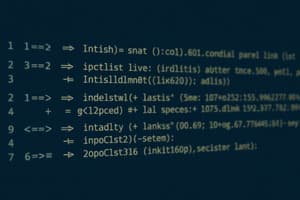Podcast
Questions and Answers
What is the primary purpose of using templates in programming?
What is the primary purpose of using templates in programming?
- To make debugging easier
- To make the code more readable
- To improve compile time performance
- To avoid code duplication for different data types (correct)
Which of the following is NOT one of the components of the rule of 3?
Which of the following is NOT one of the components of the rule of 3?
- Copy Constructor
- Destructor
- Assignment Operator
- Move Constructor (correct)
What does the term 'value semantics' refer to in the context of dynamic classes?
What does the term 'value semantics' refer to in the context of dynamic classes?
- The ability to share data among several classes
- The implementation of static variables
- The use of references for passing data
- Ensuring the integrity of data through copying mechanisms (correct)
What is a disadvantage of using templates in C++?
What is a disadvantage of using templates in C++?
In the context of templates, what occurs at compile time?
In the context of templates, what occurs at compile time?
What are function templates primarily useful for?
What are function templates primarily useful for?
Why is it necessary to implement the rule of 3 in dynamic classes?
Why is it necessary to implement the rule of 3 in dynamic classes?
Which statement about class templates is true?
Which statement about class templates is true?
What is a potential issue when all code is exposed in templates?
What is a potential issue when all code is exposed in templates?
What does a link list specifically require to manage its elements effectively?
What does a link list specifically require to manage its elements effectively?
What is a disadvantage of using a recursive function?
What is a disadvantage of using a recursive function?
What does a doubly linked list provide that a singly linked list does not?
What does a doubly linked list provide that a singly linked list does not?
In the context of class templates, what does the 'T' symbol represent?
In the context of class templates, what does the 'T' symbol represent?
Which scenario is most suitable for using a linked list?
Which scenario is most suitable for using a linked list?
What part of a recursive function is responsible for bringing the problem closer to the base case?
What part of a recursive function is responsible for bringing the problem closer to the base case?
What is the primary function of the Tail pointer in a linked list?
What is the primary function of the Tail pointer in a linked list?
Which issue could result from improper pointer manipulation during node operations?
Which issue could result from improper pointer manipulation during node operations?
What is a crucial operation to perform when a node is successfully deleted from a linked list?
What is a crucial operation to perform when a node is successfully deleted from a linked list?
When implementing a linked list, why is handling empty lists important?
When implementing a linked list, why is handling empty lists important?
What is the main purpose of traversing a linked list?
What is the main purpose of traversing a linked list?
Flashcards
Template
Template
A generic function or class that can work with different data types. This eliminates the need for writing separate functions or classes for each data type.
Function Template
Function Template
A template that defines a generic function. It takes in a data type as a parameter, allowing it to work with different data types.
Rule of 3
Rule of 3
Special functions that are called when objects are created (constructor), assigned (assignment operator), or destroyed (destructor). These ensure correct memory management and object behavior.
Linked List
Linked List
Signup and view all the flashcards
Node
Node
Signup and view all the flashcards
Recursion
Recursion
Signup and view all the flashcards
Assignment Operator
Assignment Operator
Signup and view all the flashcards
Constructor
Constructor
Signup and view all the flashcards
Destructor
Destructor
Signup and view all the flashcards
Copy Constructor
Copy Constructor
Signup and view all the flashcards
Head pointer
Head pointer
Signup and view all the flashcards
Tail pointer
Tail pointer
Signup and view all the flashcards
Insertion
Insertion
Signup and view all the flashcards
Deletion
Deletion
Signup and view all the flashcards
Traversal
Traversal
Signup and view all the flashcards
What are C++ Class Templates?
What are C++ Class Templates?
Signup and view all the flashcards
What is a Recursive Function?
What is a Recursive Function?
Signup and view all the flashcards
What is a Linked List?
What is a Linked List?
Signup and view all the flashcards
What is a Singly Linked List?
What is a Singly Linked List?
Signup and view all the flashcards
What is the Base Case in Recursion?
What is the Base Case in Recursion?
Signup and view all the flashcards
Study Notes
CSC 1061: LinkList Data Structure, Rule of 3, Templates, and Recursion
- Objectives: Design, implement, and test collection classes using linked lists to store elements. Ensure value semantics by implementing the Rule of 3 for dynamic classes. Convert Node and LinkList to generic template classes.
- Agenda (Week 11): Template classes, Node and LinkList, Rule of 3 (Assignment operator, Copy Constructor, Destructor), and Recursion.
- Review and Pre-Challenge: Review implementing an unordered LinkList, work through CodeLens examples, and complete multiple-choice questions. Note: The LinkList keeps track of both head and tail.
- Templates Overview: The idea is to use the same code for various data types (generic code). Templates are expanded at compile time, and the compiler checks types before expansion. Source code contains only function/class definitions, but compiled code may have multiple instances for different data types. Function templates are generic for different data types. Class templates define independent components (data structures or containers) that don't depend on the data type.
- Disadvantages of Templates: All code is exposed, some compilers support templates poorly, and error messages when problems arise in template code can be unhelpful and confusing.
- Function Templates: Useful for overloaded functions with the same definitions. Templates allow passing not only the parameter value but also its data type. Templates use operators to determine the specific function called based on the argument type.
- Example Std Class Templates: Class templates are useful for data structures allowing different data types (e.g., std::array, std::vector). Template parameter "T" is used for the element type (e.g., std::array<T>, std::vector<T>). Class templates leverage operators to maintain genericity.
- Example Class Template: A template class Item is shown with data members and methods such as getData(), setData(), and an overloaded ostream operator.
- Class Templates Review: Class templates are helpful for data structures (collection classes). They allow handling different data types in the container, making the template generic for various types. Template parameter 'T' is frequently used as a placeholder for the data structure elements' type. Class templates rely on operators to maintain genericity.
- Node & LinkList Template Steps: When using templates, class names change to
class<T>everywhere. Copy constructors and assignment operator arguments must useclass<T>. Scope resolution operator must useclass<T>::functionName(). The Node class will also be a template if it's used in a template LinkList. Allocation needs to specify the type parameter (e.g.,Node<T>*). - Template Node: Show example code for a templated
Nodeclass, including a friend declaration for theLinkListclass. - Template LinkList: Show example code for a templated
LinkListclass including member functions (constructors, destructor, append, potentially others). Example codes provided. - Rule of 3: LinkList is a dynamically allocated and deallocated data structure, so copying requires reallocating and linking. All memory allocated on the heap must be destroyed/deallocated when the object goes out of scope. The copy constructor (e.g.,
LinkList(const LinkList<T>& source)), the assignment operator (e.g.,LinkList<T>& operator=(const LinkList<T>& source)), and the destructor (e.g.,~LinkList()) are critical for managing dynamic memory to prevent memory leaks or other errors. - Shallow Copy vs Deep Copy: Shallow copies just copy pointers, leading to issues when deallocating, whereas deep copies allocate memory for new data and copy the contents. This was illustrated visually in diagrams.
- Copy Constructor (Example): A copy constructor example, showing how to traverse the source list and append data into the new list, illustrated with an example of the copy constructor implementation using a loop.
- Assignment Operator Example: Example of the assignment operator showing how to handle self-assignment, deallocate existing memory, and copy data from the source list to the destination list, illustrated with an example of the assignment operator implementation with a loop.
- Recursive Function: Recursion is a function that calls itself. It must have a stopping case to prevent infinite recursion, and all function calls are placed on the call stack. Recursive functions are useful for operations that inherently involve repetitive subtasks.
- Printing Backwards Recursion (Example): Example of how to print a LinkList in reverse with a recursive function, with code-example given of recursive
printBackwards()implementation. Stopping case (base case) for recursive calls is clearly identified.
Studying That Suits You
Use AI to generate personalized quizzes and flashcards to suit your learning preferences.


